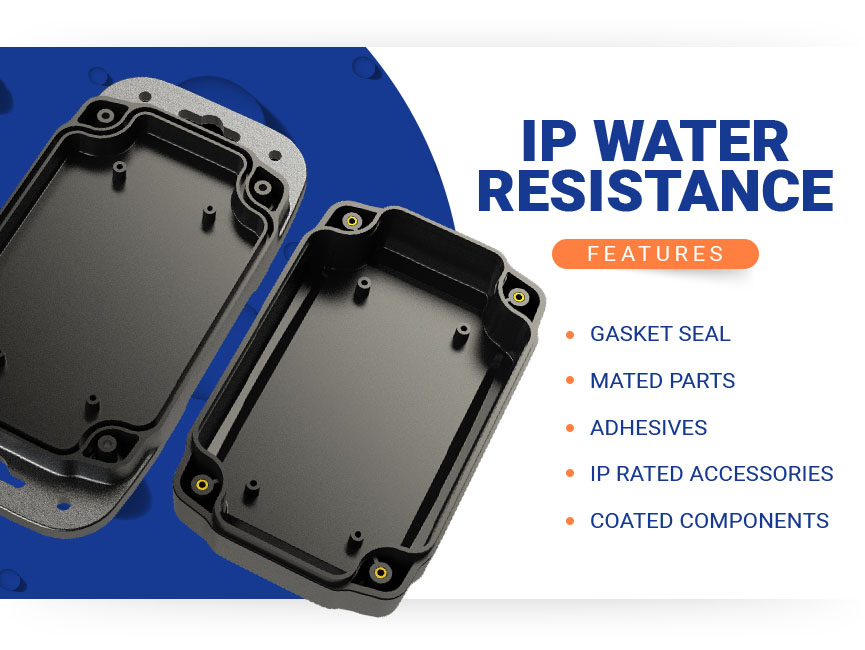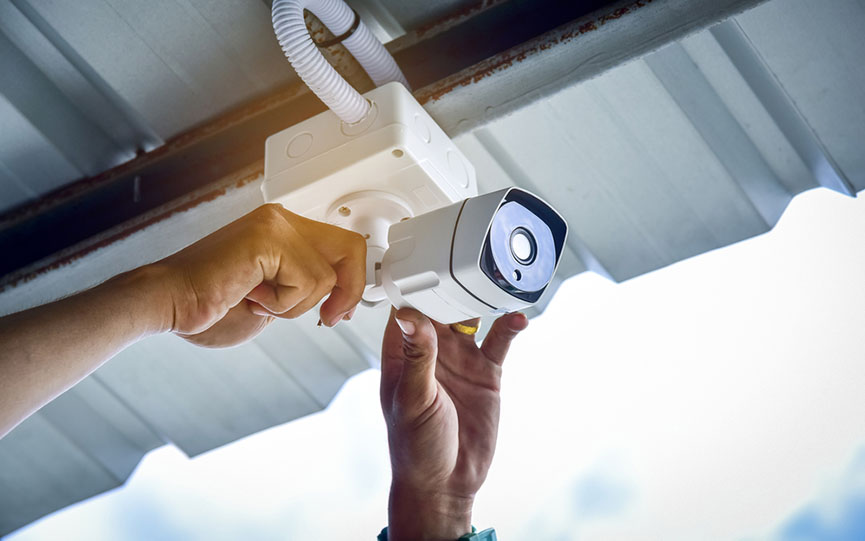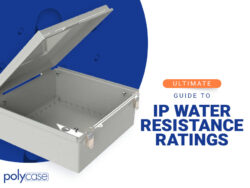- URL
Share

We depend on waterproofing to protect our comfort and safety in many aspects of life. The weather stripping on a car prevents everyone inside from getting soaked as they drive through a rainstorm. When we have to be out in wet weather, we’re thankful for waterproof jackets. Well-built roofs prevent water from damaging our homes and businesses.
By the same token, it’s important for anyone designing electronic devices and/or electrical systems to be familiar with IP water resistance ratings. This rating scale provides an easy way to assess how well waterproof enclosures protect against splashing, hose sprays, submersion and other water hazards that electrical devices often encounter.
In this guide, we’ll give you a brief overview of IP water resistance ratings and how they work. Need a dependable waterproof electrical box for your project? We’ll also talk about Polycase’s selection of IP rated waterproof enclosures and how they can help protect your most sensitive devices.
What Is an IP Rating?
An IP rating is a two-digit performance rating for an electrical device or enclosure. These ratings provide key information about the degree of protection that an enclosure provides against ingress from two classes of hazards: solid ingress and liquid water ingress. A few examples include IP55 and IP67, although there are dozens of possible ratings.
The two digits of every IP rating work as follows:
- The first digit is the solid ingress protection rating, which encompasses protection against accidental contact, dust, debris and any other solid materials, rated on an ascending scale of 0 to 6.
- The second digit is the water resistance rating, which rates its protection against the ingress of water on an ascending scale of 0 to 9.

Each level on the scale corresponds to a specific degree of water ingress protection. For example, a 7 in the second digit means the enclosure provides protection against temporary submersion at a depth of up to one meter.
Degrees of IP Water Resistance
Here’s a quick summary of the levels of water resistance in the IP scale, as described in the official IP ratings code:
- IPx0: No protection from water
- IPx1: Protected against vertically falling water drops
- IPx2: Protected against vertically falling water drops when enclosure tilted up to 15º
- IPx3: Protected against spraying water
- IPx4: Protected against splashing water
- IPx5: Protected against water jets
- IPx6: Protected against powerful water jets
- IPx7: Protected against the effects of temporary immersion in water
- IPx8: Protected against the effects of continuous immersion in water
- IPx9: Protected against high pressure and temperature water jets
Note that IPx9 ratings are rarely used. Aside from a small number of specialty applications that use IP69K enclosures, most applications treat IP68 as the highest IP enclosure rating.

Why a Water Resistant IP Enclosure Is Important
- Protection from Water Damage: Water ingress can damage electrical and electronic equipment in an instant. The consequences can be especially severe for devices that encounter submersion, hose-directed water or other high-level water hazards. IP ratings provide a simple and widely recognized tool that allows device designers and engineers to select an enclosure with the right waterproofing features.
- Outdoor Performance: Due to the hazards like rain, snow and flooding that outdoor enclosures often encounter, choosing an IP rated enclosure is particularly important when selecting an outdoor electrical box. However, even indoor enclosures may require IP ratings if they’re located in areas where splashing or dripping water is a common hazard.
- Regulatory Compliance: Widely used safety regulations like NFPA 70E stipulate that electrical enclosures in certain applications have to carry a specific IP rating. To stay in compliance and maintain a high standard of safety, it’s important that every business verifies the IP ratings of any enclosures that are required to have them.
- International Validity: The IP rating scale is based on IEC 60529, a global standard set by the International Electrotechnical Commission. The system is in common use across the EU, Asia and North America, which allows businesses in global markets to confidently select waterproof enclosures.
How Does IP Water Resistance Work?
Enclosures and devices can include a variety of features that allow them to achieve IP rated compliance. These are the most common:

- Gasket Seal: Many IP rated enclosures use a silicone rubber gasket to seal out water. The gasket fits into a groove inside the enclosure and prevents water from entering through the enclosure’s seams or panels.
- Mated Parts: IP rated enclosures are typically designed with mated parts that fit together tightly. The tight space makes it much more difficult for water to enter the enclosure, and it can also improve the enclosure’s security.
- Adhesives: Using a waterproof adhesive to glue the parts of an enclosure together can improve its water resistance significantly.
- IP Rated Accessories: For enclosures used as outdoor junction boxes or for another application that requires cutouts and pass-throughs, accessories like cable glands and vents are essential for maintaining the enclosure’s IP rating. To make sure your enclosure accessories are up to the task, look for accessories that feature IP ratings themselves.
- PCB Potting and Conformal Coating: Device designers use these protective measures to give their devices IP rated performance. By filling the enclosure with certain waterproof compounds (known as PCB potting) or coating its components with a water resistant film (known as conformal coating), device manufacturers can help protect the enclosure’s components from water.
How Does an IP Water Resistance Test Work?
Independent testing is essential for confirming that an enclosure actually performs at its advertised IP rating. That’s why reputable enclosure manufacturers submit their products for testing through Underwriters Laboratories (now simply called UL).
UL is an independent safety testing organization that uses rigorous methods to verify compliance with industry standards like the IP scale. In the process of testing an enclosure’s protective capabilities, UL analyzes data from tests such as:
- Projecting pressurized water jets at the enclosure from one or more directions
- Submerging the enclosure at a specified depth and length of time
- Simulating different types of water flow, such as indirect splashing and dripping
Testers from UL sometimes test the products in their own facilities and sometimes work with manufacturers to verify their testing data. Either way, UL’s ultimate goal is to determine whether the enclosure prevented water ingress sufficiently to comply with its standards. An enclosure that passes the test gains UL Listed status, which anyone can verify through UL’s Product iQ service.
Every IP rated enclosure from Polycase is UL Listed to ensure reliable performance. For more key information on how UL testing works, including how to verify an enclosure’s UL test rating, see our guide to UL Listed enclosures.

What IP Water Resistance Ratings Can’t Tell You
An IP water resistance rating can communicate a surprising amount of information with just one number. However, that doesn’t necessarily mean that they contain everything one might need to know about an enclosure’s resistance to liquid hazards. These are some of the most important factors that you won’t find accounted for in an IP rating:
- Resistance to Other Liquids: IP ratings only measure protection against water, not other liquids like oil, soap or coolant. Depending on the context of your enclosure’s use, it may be important to evaluate its resistance to any other liquid substances of concern. NEMA 13 rated enclosures are a great place to start if your application requires oil and coolant resistance.
- Corrosion Resistance: The IP scale does not measure resistance to corrosion hazards such as salt water or corrosive chemicals. If your enclosure needs to withstand corrosion, look for a NEMA 4X rated enclosure that also fulfills your IP rating requirements.
- Ice-Over Resistance: In colder climates, ice forming on the surface of an outdoor enclosure can be a serious concern for the function of its lock and hinges. Alongside any required IP ratings, look for a NEMA 3S or NEMA 3SX rated enclosure if ice-overs are a concern.
- IP68 Depth and Time: The IP68 rating has an important caveat because of its position at the top of the rating scale: It doesn’t specify exactly how long or at which depth an enclosure has to keep water out — only that the conditions have to be agreed upon by the manufacturer and buyer. If your application requires resistance to deep and/or prolonged submersion, it’s important to check the specific stats of an IP68 enclosure model to learn more detailed specs.
TIP: Need to brush up on the NEMA enclosure ratings that are widely used in North America? See our NEMA vs. IP guide for a quick comparison primer, and check out our IP to NEMA conversion guide to learn how the two systems can work together.
What Waterproof IP Rating Does My Enclosure Need?
Determining the best waterproof IP rating for your enclosure always starts with evaluating the requirements of your application. Establish the environmental hazards that your device could encounter, including (but not limited to):
- Rain, snow and sleet
- Sprays from pressurized hoses
- Complete submersion, whether temporary or prolonged
- Dripping and splashing water
With these factors in mind, consult an IP ratings chart and determine which rating is most appropriate for your enclosure selection. Remember that it’s usually better to choose an enclosure that’s more protective than your application requires. For example, if you’re deciding between IP67 vs. IP68 enclosures, it makes sense to choose IP68 if you’re not sure about the depth and time that your enclosure might be submerged.

Fortunately, Polycase makes it easy to find an enclosure with the IP rating you need or better. We build our enclosures to offer the highest IP ratings possible for their design. Many of our enclosure models carry higher IP ratings such as IP66 and IP68 in addition to lower ratings. Thus, no matter what IP rating your application requires, Polycase offers a customizable enclosure solution for you.
Note: Many electrical enclosures require solid ingress protection, too. See our guide to dust proof IP ratings and our complete IP ratings guide for more information to help you make the right choice on an IP rated enclosure.
Waterproof IP Rated Enclosures from Polycase
Polycase’s lineup of enclosures offers much more than a simple selection of cost-effective enclosures. We’ve designed many of our electrical boxes for IP rated water protection, including top-of-the-line IP68 enclosures for complete protection against water ingress.
These models are among Polycase’s top IP box offerings:
IP66 Enclosures
- Polycase SA Series: These stainless steel enclosures are built for long-term performance and offer NEMA 4X corrosion protection.
- Polycase WC Series: Our popular and economical WC Series models are molded from durable polycarbonate and provide al transparent cover.
- Polycase EX Series: A high quality extruded aluminum design makes these indoor electronics enclosures both reliable and appealing.
IP68 Enclosures
- Polycase HD Series: The HD Series offers IP68 performance and rugged polycarbonate construction at a highly affordable price point.
- Polycase ZH and ZQ Series: These impact-resistant polycarbonate enclosures are available with an optional hinged cover, plus modular mounting bosses and panels for a huge variety of configurations.
- Polycase AN Series: Our diecast aluminum AN Series models are among our toughest enclosures, and they offer NEMA 4X corrosion resistance.
In search of more IP rated enclosure options? Browse our selection of dozens of IP rated enclosure models in a huge variety of materials and IP ratings. Looking for customized enclosure options? Get started now with our Instant Quote tool!
Image Credits
ann_ounce/Shutterstock.com
alula.JCpro/Shutterstock.com
APChanel/Shutterstock.com
0 Comment
